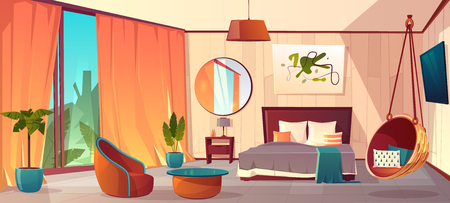Introduction: Bridging Feng Shui and British Comfort
As the days grow shorter and the cold settles in across the United Kingdom, creating a warm and inviting home becomes both an art and a science. While traditional British approaches to winter cosiness often centre around roaring fireplaces, thick curtains, and hearty textiles, there is growing curiosity about how Eastern philosophies—particularly Feng Shui—might offer fresh perspectives on snug interiors. Feng Shui, the ancient Chinese practice of harmonising people with their surroundings, is grounded in the belief that spatial arrangement and energy flow can profoundly influence well-being. This article explores how these time-honoured principles can be thoughtfully adapted to address the distinctive challenges posed by British winters. By merging Feng Shui’s focus on balance and positive energy with quintessentially British notions of comfort, we set the stage for a new approach to warmth—one that nurtures both body and spirit during the chilliest months of the year.
Understanding Warmth in UK Homes: Cultural and Practical Insights
The British winter is a season marked by short days, long nights, and a persistent damp chill that seeps through even the sturdiest of walls. Unlike more severe continental climates, the UK’s winters are often characterised by moderate temperatures hovering just above freezing, but it is the omnipresent humidity and biting winds that truly test one’s resolve for comfort. In response, both architecture and culture have evolved to embrace warmth as a treasured commodity.
Architectural Features: Tradition Meets Function
British homes are renowned for their distinctive features designed to shield inhabitants from the elements. From Victorian terraces to modern semi-detached houses, several architectural elements are commonly found across the UK:
| Feature | Description | Warmth Benefit |
|---|---|---|
| Thick Masonry Walls | Solid brick or stone construction | Retains heat, blocks drafts |
| Sash Windows (often double-glazed) | Traditional sliding windows, increasingly fitted with insulation | Minimises heat loss |
| Fireplaces & Hearths | Central gathering point in many living rooms | Provides radiant heat, fosters social cosiness |
| Curtains & Draught Excluders | Heavy fabrics at windows and doors | Reduces cold air infiltration |
| Centrally Heated Radiators | Common in modern households | Ensures even warmth throughout rooms |
The Cultural Significance of Cosiness: Hygge and Beyond
The importance of comfort during the colder months has become deeply rooted in British culture. While the Danish concept of ‘hygge’—the art of creating joy and cosiness—has captured global imagination, Britons have long cherished their own rituals of warmth. The quintessential “snug”—a small, intimate room in traditional pubs or homes—embodies this desire for sheltered comfort. Whether it’s curling up with a hot cuppa under a woollen throw, gathering around an open fire, or retreating to a softly lit alcove, these moments are celebrated antidotes to winter’s gloom.
Comfort Rituals in British Homes vs. Scandinavian Hygge
| British Approach | Hygge Elements (Scandinavian) |
|---|---|
| Emphasis on hot drinks (tea), fireplaces, layered textiles, and reading nooks | Candles, simple pleasures, shared meals, natural materials like wood and wool |
| Pubs and snugs as social havens from the cold | Cosy gatherings with friends and family at home |
| Aesthetic focus on soft lighting and deep colours for warmth perception | Neutral palettes with emphasis on light maximisation for brightness during dark months |
Tying Tradition to Modern Comforts Through Feng Shui Principles
This collective pursuit of snugness aligns seamlessly with Feng Shui’s ethos: harmonising interiors to foster wellbeing. By understanding both the cultural roots of British cosiness and practical solutions for heat retention, we can better appreciate how ancient Eastern wisdom may be thoughtfully adapted to enhance the science of warmth within UK homes.

3. Feng Shui Fundamentals: Inviting Warmth and Balance
At the heart of Feng Shui lies the concept of Qi (pronounced “chee”), the life energy that flows through our living spaces. For UK homes bracing against long, chilly winters, managing this flow becomes essential to cultivating both physical warmth and an inviting atmosphere. Feng Shui encourages us to pay careful attention to how energy moves through a room, ensuring there are no blockages caused by clutter or poorly arranged furniture. In a British context—where period features, bay windows, and fireplaces abound—positioning seating areas to face sources of natural light or the hearth can foster a sense of togetherness and gentle heat circulation.
Colour Choices for Cosiness
Traditional Feng Shui associates certain colours with warmth and emotional wellbeing. Deep earth tones, rich reds, and warm golds not only invite visual comfort but also echo the hues of autumn leaves and glowing embers—a perfect match for the UK’s often grey winter days. Incorporating these shades in soft furnishings such as cushions, throws, and rugs adds layers of snugness without overwhelming typically compact British rooms.
Material Selection: Embracing Natural Textures
The tactile qualities of your home matter just as much as the visual ones. Feng Shui favours natural materials like wood, wool, cotton, and stone, which bring a grounded energy to interiors. In the UK, where historic cottages and Victorian terraces are celebrated for their character, blending traditional wooden flooring or exposed brickwork with plush textiles creates a harmonious balance between old-world charm and modern comfort.
Balancing Yin and Yang in a British Setting
Feng Shui seeks equilibrium between Yin (soft, dark, passive) and Yang (bright, active) energies. During winter months, British interiors can lean towards Yin—with shorter days and subdued natural light—so it’s vital to introduce Yang elements: strategically placed mirrors to reflect daylight, metallic accents for brightness, or candles for gentle illumination. By thoughtfully applying these principles, even the dreariest day is transformed into an opportunity for warmth and emotional sanctuary within your home.
4. Room-by-Room Strategies: Practical Feng Shui Applications
Transforming your UK home into a warm and inviting haven through Feng Shui starts with tailored strategies for each room. The approach blends ancient wisdom with practical, modern comforts—ideal for warding off winter’s chill. Below, we explore key areas in a typical British household and offer actionable advice to maximise snugness using arrangement, lighting, and textures.
Living Room: Central Harmony and Comfort
The living room often serves as the heart of the home, especially during long UK winters. Arrange sofas and chairs in a circular or semi-circular fashion to foster conversation and retain warmth. Position seating away from draughty windows or doors; if unavoidable, use thick curtains or screens as protective barriers. Introduce layered lighting—a mix of floor lamps, table lamps, and wall sconces—to soften harsh winter evenings. Opt for plush throws, velvet cushions, and woollen rugs to create tactile comfort underfoot and at hand.
Bedroom: Restorative Warmth
For bedrooms, Feng Shui recommends positioning the bed so you can see the door but are not directly in line with it (the “command position”), promoting both safety and serenity. Use bedside lamps with warm-toned bulbs to mimic candlelight. Layer bedding with natural fibres such as cotton flannel sheets and heavy duvets; add a faux fur or knitted blanket at the foot for extra cosiness. Keep clutter minimal beneath the bed to allow positive energy (Qi) to flow freely, aiding restful sleep.
Kitchen: Nourishing Energy
The kitchen is where warmth literally begins. Place the dining table so diners face one another rather than walls or corners, encouraging connection and laughter—key aspects of snugness in British homes. Use open shelves for easy access to crockery and mugs, keeping essentials within reach but surfaces tidy. Soft under-cabinet lighting helps brighten gloomy days without overwhelming glare. Consider adding textured seat cushions or patterned tea towels for subtle layers of warmth.
Feng Shui Snugness Tips by Room
| Room | Furniture Arrangement | Lighting | Textures |
|---|---|---|---|
| Living Room | Circular/semi-circular seating; avoid draughts | Layered (lamps & sconces) | Plush throws, velvet cushions, wool rugs |
| Bedroom | Bed in command position; minimal clutter | Warm bedside lamps | Cotton flannel sheets, heavy duvets, faux fur blankets |
| Kitchen | Table facing diners; open shelving | Soft under-cabinet lights | Padded seat cushions, textured tea towels |
| Bathroom | Tidy storage; non-slip mats near bath/shower | Dimmer lights/candles for evening baths | Thick towels, bath mats, woven baskets |
| Hallway/Entryway | Shoe racks/benches to reduce clutter; coat hooks accessible | Wall lights for gentle illumination | Runners/rugs to trap warmth from outside |
The Little Details: Accessories & Scent
Add finishing touches with scented candles—think sandalwood or cinnamon—to evoke a sense of comfort. Houseplants like English ivy or ferns introduce life force (Sheng Qi), purifying indoor air while softening hard corners typical of Victorian terraces or Edwardian semis. Remember: in Feng Shui, every detail contributes to an atmosphere of nurturing warmth that makes coming home on a frosty evening truly delightful.
5. Embracing British Heritage: Incorporating Local Elements
To craft a truly inviting home during the UK’s chilly winters, blending Feng Shui principles with quintessentially British elements offers both warmth and authenticity. Integrating local heritage into your interiors isn’t just about aesthetics—it’s about creating a space that resonates with personal and regional stories while supporting positive energy flow.
Infusing Traditional Tartans for Comfort and Colour
Tartan patterns are woven into the very fabric of British culture, particularly in Scotland. Incorporate tartan throws or cushions to bring in a pop of colour and pattern that instantly feels snug. According to Feng Shui, textiles in rich reds, greens, or blues can promote warmth and balanced energy, making tartan an ideal choice for adding both visual interest and comfort to living spaces.
Celebrating Local Woods for Earthy Stability
The use of native woods such as oak, ash, or beech not only reflects British craftsmanship but also aligns with the Feng Shui element of wood, representing growth and vitality. Choose locally crafted furniture or reclaimed wood accessories—like side tables or mantelpieces—to ground your interiors and foster a sense of enduring stability. The tactile nature of these materials invites touch and connection, enhancing the feeling of cosiness.
Curating Vintage Finds for Personal Connection
British flea markets and antique shops are treasure troves for unique finds that infuse your space with character. Select vintage mirrors to amplify light—a classic Feng Shui technique—or display inherited ceramics and brass candlesticks to honour your family’s past. These items tell stories, evoke nostalgia, and establish a meaningful link between generations, all while supporting harmonious energy flow throughout your home.
By thoughtfully combining these elements—tartan for vibrancy, local woods for grounding, and vintage pieces for personality—you create a winter sanctuary that not only radiates warmth but also echoes the spirit of British heritage through the lens of Feng Shui.
6. Sustainable Warmth: Eco-Friendliness and Modern Innovations
As we seek to create warm, inviting interiors during the brisk UK winters, embracing sustainability is not just a modern trend but also deeply aligned with Feng Shui principles. At its heart, Feng Shui champions harmony with the environment, advocating for mindful choices that foster balance and wellbeing within the home. This philosophy naturally complements the growing British emphasis on eco-friendly living and innovative solutions.
The Synergy of Feng Shui and Sustainability
Traditional Feng Shui encourages us to use natural materials and to design spaces that invite positive energy—or “chi”—into our homes. In the UK, this translates beautifully into choosing sustainable furnishings made from responsibly sourced wood, wool, or recycled textiles. These materials not only promote warmth and comfort but also help reduce our carbon footprint, echoing the environmental consciousness that is increasingly integral to British life.
Draught-Proofing: The Old Meets the New
One of the most practical modern innovations for UK households is draught-proofing. By sealing gaps around windows and doors, you prevent heat loss—an idea that resonates with the Feng Shui principle of containing beneficial energy within your space. Using eco-friendly draught excluders or recycled insulation materials ensures your home stays snug while maintaining environmental responsibility.
Smart Thermostats and Intelligent Heating
Another contemporary solution is integrating smart thermostats into your home’s heating system. These devices allow you to monitor and adjust temperatures remotely, ensuring rooms are only heated when needed—a practice that echoes Feng Shui’s focus on energy efficiency and flow. Many British homes now benefit from these innovations, reducing both energy bills and environmental impact while enhancing overall comfort during winter’s chill.
Lighting for Warmth and Efficiency
Feng Shui advises thoughtful lighting to nurture a sense of wellbeing. Switching to LED bulbs or smart lighting systems brings together low energy consumption with adaptability, allowing you to create cosy atmospheres without wastefulness. Soft, layered lighting in living areas supports both relaxation and responsible energy use—a hallmark of both good Feng Shui and modern British living.
A Harmonious Path Forward
By blending the wisdom of Feng Shui with the latest sustainable innovations—from draught-proofing Victorian terraces to installing intelligent heating in new builds—UK homeowners can cultivate interiors that are as warm in spirit as they are in temperature. In doing so, we create homes that honour tradition, embrace progress, and care for both our families and the planet.
7. Conclusion: Harmonising Tradition and Modernity for a Cosy British Winter
As the cold months settle over the UK, the fusion of Feng Shui’s ancient philosophy with contemporary British living offers a refreshing approach to winter comfort. By thoughtfully arranging interiors to harness both energy flow and warmth, homes can transcend mere functionality and become sanctuaries of seasonal wellbeing. The integration of Feng Shui principles—such as decluttering, mindful placement of furniture, and a focus on natural light—empowers homeowners to craft spaces that are not only snug but also uplifting during the darker days. Embracing these time-honoured practices doesn’t mean abandoning modern style or convenience; rather, it encourages a dialogue between tradition and innovation, where each enhances the other. From soft furnishings in rich textures to intelligent use of colour and sustainable heating solutions, every detail becomes an opportunity to balance harmony with practicality. Ultimately, by reimagining our interiors through the lens of Feng Shui, we invite both warmth and positive energy into our homes—transforming winter from a season of endurance to one of genuine comfort and connection.


